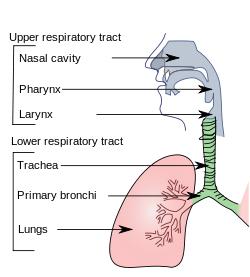 Upper respiratory tract
Air enters through nasal cavity and passes down towards pharynx and larynx.
Upper respiratory tract
Air enters through nasal cavity and passes down towards pharynx and larynx.
The upper respiratory tract or upper airway primarily refers to the parts of the respiratory system lying outside of the thorax.
The upper respiratory tract consists of the nose and the pharynx. Its primary function is to receive the air from the external environment and filter, warm and humidify it before it reaches the delicate lungs where gas exchange will occur.
Air enters through the nostrils of the nose and is partially filtered by the nose hairs, then flows into the nasal cavity. The nasal cavity is lined with epithelial tissue, containing blood vessels, which help warm the air; and secrete mucous, which further filters the air. The endothelial lining of the nasal cavity also contains tiny hair–like projections, called cilia. The cilia serve to transport dust and other foreign particles, trapped in mucous, to the back of the nasal cavity and to the pharynx. There the mucus is either coughed out, or swallowed and digested by powerful stomach acids. After passing through the nasal cavity, the air flows down the pharynx to the larynx. The larynx is also called the voice box and has the associated cartilage that produces sound.